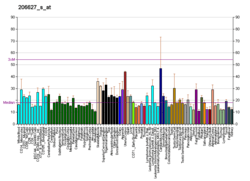Further reading
- Crew AJ, Clark J, Fisher C, et al. (1995). "Fusion of SYT to two genes, SSX1 and SSX2, encoding proteins with homology to the Kruppel-associated box in human synovial sarcoma". EMBO J. 14 (10): 2333–40. PMC 398342. PMID 7539744.
- Clark J, Rocques PJ, Crew AJ, et al. (1994). "Identification of novel genes, SYT and SSX, involved in the t(X;18)(p11.2;q11.2) translocation found in human synovial sarcoma". Nat. Genet. 7 (4): 502–8. doi:10.1038/ng0894-502. PMID 7951320.
- Sinke RJ, de Leeuw B, Janssen HA, et al. (1993). "Localization of X chromosome short arm markers relative to synovial sarcoma- and renal adenocarcinoma-associated translocation breakpoints". Hum. Genet. 92 (3): 305–8. doi:10.1007/BF00244478. PMID 8406438.
- Chand A, Clark J, Cooper CS, Craig IW (1997). "Long-range organization of reiterated sequences, including the SSX1 cDNA at the OATL1 cluster in Xp11.23". Genomics. 30 (3): 545–52. doi:10.1006/geno.1995.1275. PMID 8825641.
- Thaete C, Brett D, Monaghan P, et al. (1999). "Functional domains of the SYT and SYT-SSX synovial sarcoma translocation proteins and co-localization with the SNF protein BRM in the nucleus". Hum. Mol. Genet. 8 (4): 585–91. doi:10.1093/hmg/8.4.585. PMID 10072425.
- Kato H, Tjernberg A, Zhang W, et al. (2002). "SYT associates with human SNF/SWI complexes and the C-terminal region of its fusion partner SSX1 targets histones". J. Biol. Chem. 277 (7): 5498–505. doi:10.1074/jbc.M108702200. PMID 11734557.
- de Bruijn DR, dos Santos NR, Kater-Baats E, et al. (2002). "The cancer-related protein SSX2 interacts with the human homologue of a Ras-like GTPase interactor, RAB3IP, and a novel nuclear protein, SSX2IP". Genes Chromosomes Cancer. 34 (3): 285–98. doi:10.1002/gcc.10073. PMID 12007189.
- Yang K, Lui WO, Xie Y, et al. (2002). "Co-existence of SYT-SSX1 and SYT-SSX2 fusions in synovial sarcomas". Oncogene. 21 (26): 4181–90. doi:10.1038/sj.onc.1205569. PMID 12037676.
- Güre AO, Wei IJ, Old LJ, Chen YT (2002). "The SSX gene family: characterization of 9 complete genes". Int. J. Cancer. 101 (5): 448–53. doi:10.1002/ijc.10634. PMID 12216073.
- Strausberg RL, Feingold EA, Grouse LH, et al. (2003). "Generation and initial analysis of more than 15,000 full-length human and mouse cDNA sequences". Proc. Natl. Acad. Sci. U.S.A. 99 (26): 16899–903. doi:10.1073/pnas.242603899. PMC 139241. PMID 12477932.
- Storlazzi CT, Mertens F, Mandahl N, et al. (2003). "A novel fusion gene, SS18L1/SSX1, in synovial sarcoma". Genes Chromosomes Cancer. 37 (2): 195–200. doi:10.1002/gcc.10210. PMID 12696068.
- Gerhard DS, Wagner L, Feingold EA, et al. (2004). "The status, quality, and expansion of the NIH full-length cDNA project: the Mammalian Gene Collection (MGC)". Genome Res. 14 (10B): 2121–7. doi:10.1101/gr.2596504. PMC 528928. PMID 15489334.
- Tvrdík D, Povýsil C, Svatosová J, Dundr P (2005). "Molecular diagnosis of synovial sarcoma: RT-PCR detection of SYT-SSX1/2 fusion transcripts in paraffin-embedded tissue". Med. Sci. Monit. 11 (3): MT1–7. PMID 15735574.
- Ross MT, Grafham DV, Coffey AJ, et al. (2005). "The DNA sequence of the human X chromosome". Nature. 434 (7031): 325–37. doi:10.1038/nature03440. PMC 2665286. PMID 15772651.
- Fernebro J, Francis P, Edén P, et al. (2006). "Gene expression profiles relate to SS18/SSX fusion type in synovial sarcoma". Int. J. Cancer. 118 (5): 1165–72. doi:10.1002/ijc.21475. PMID 16152617.
- Sun Y, Gao D, Liu Y, et al. (2006). "IGF2 is critical for tumorigenesis by synovial sarcoma oncoprotein SYT-SSX1". Oncogene. 25 (7): 1042–52. doi:10.1038/sj.onc.1209143. PMID 16247461.


